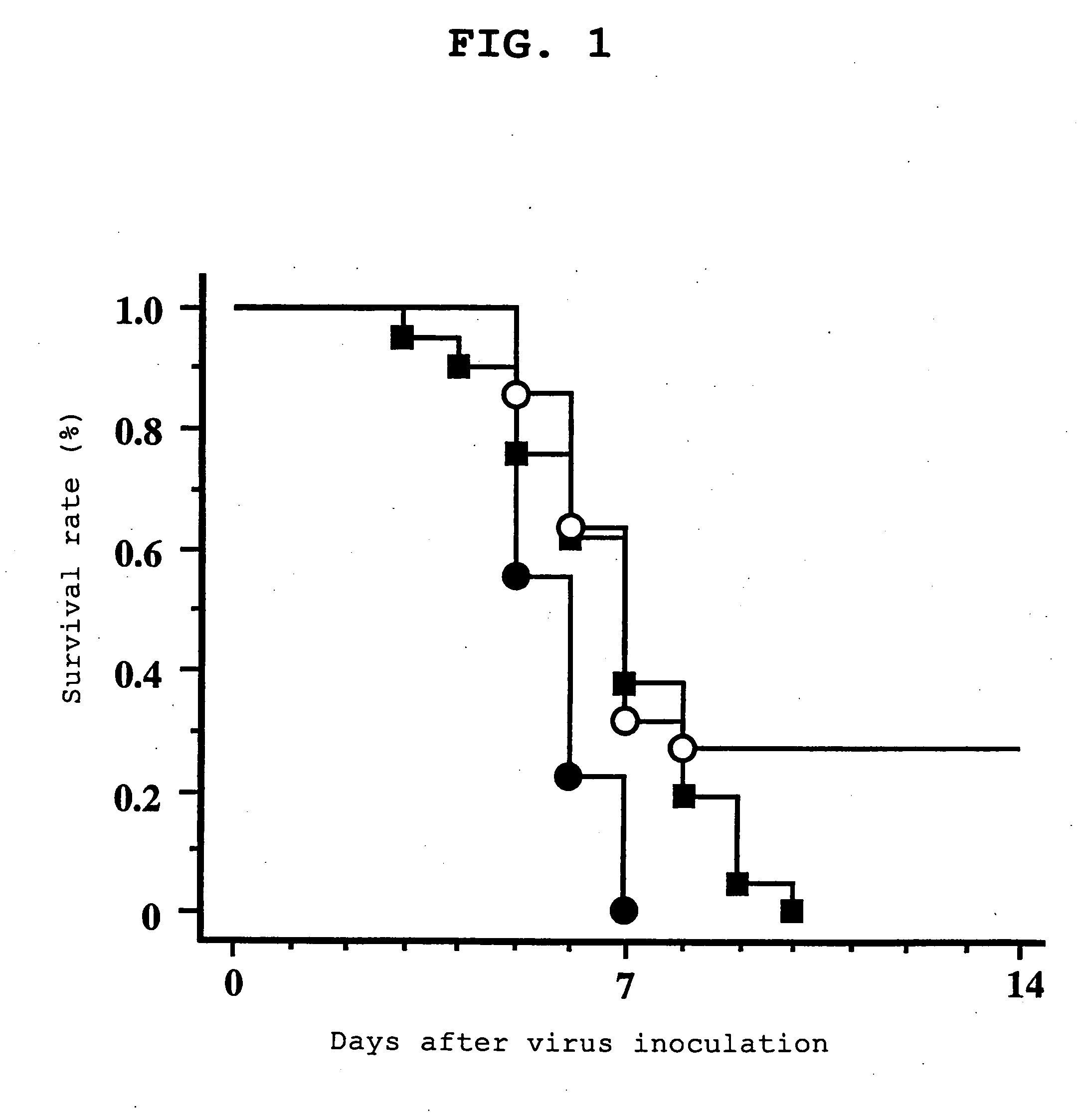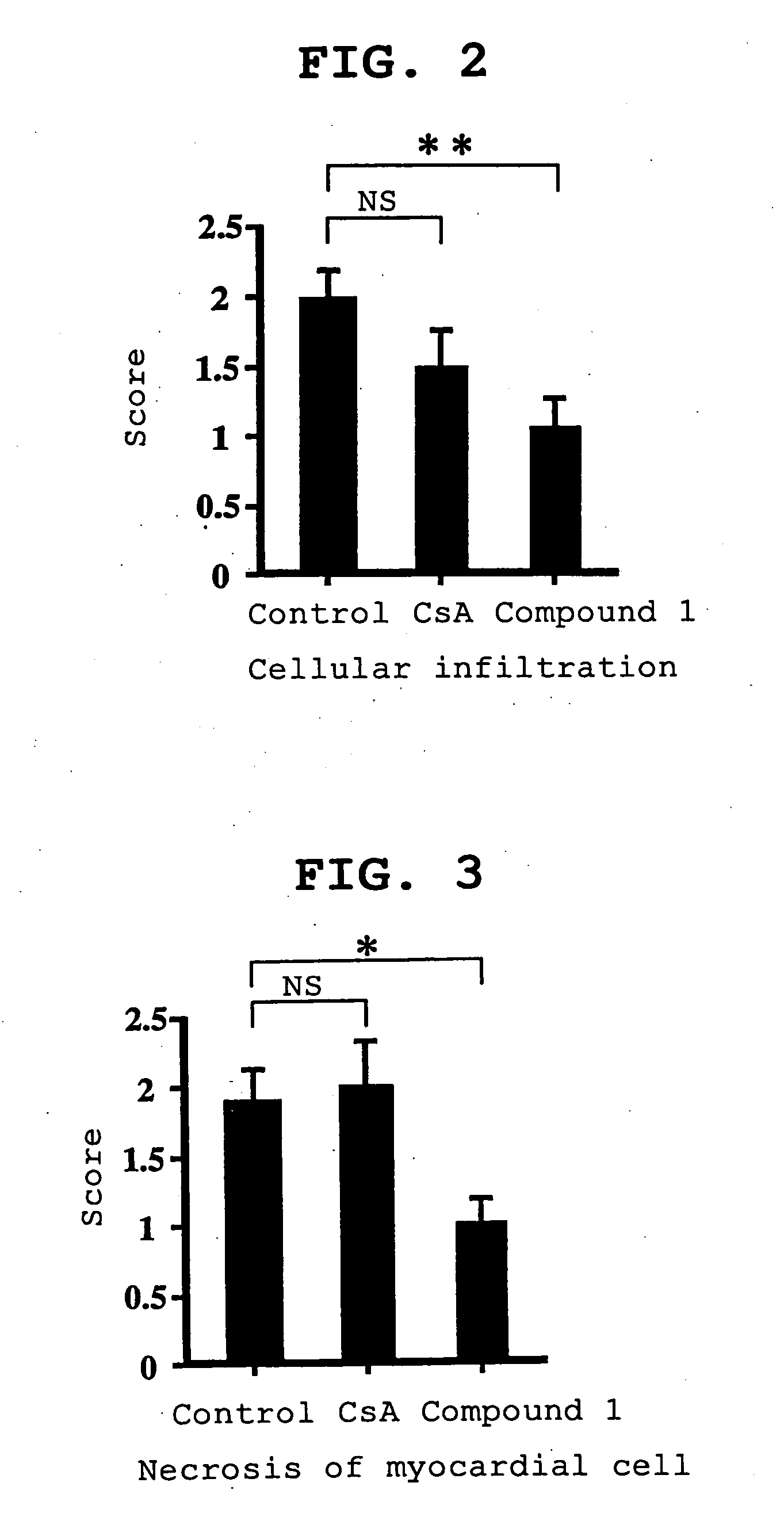Medicinal compositions for preventing or treating viral myocarditis
a technology of medicine composition and myocarditis, which is applied in the direction of drug composition, application, biocide, etc., can solve the problem of inability to specificly treat each virus, achieve the effects of improving the mortality rate of mice, improving the necrosis of myocardial cells and cellular infiltration of the heart, and improving the survival rate of mi
- Summary
- Abstract
- Description
- Claims
- Application Information
AI Technical Summary
Benefits of technology
Problems solved by technology
Method used
Image
Examples
experimental example 1
Effect on Viral Myocarditis
Compound 1: 2-Amino-2-(2-(4-octylphenyl)ethyl)propane-1,3-diol hydrochloride
(1) Survival Rate
Method
[0046] Four-week-old DBA / 2 mice were divided into 3 groups, and EMC (Encephalomyocarditis) virus (10 pfu) was intraperitoneally inoculated. After inoculation, distilled water (solvent, group A, n=11) as a control, compound 1 (1 mg / kg / day, group B, n=10), and compound 1 (3 mg / kg / day, group C, n=10) were orally administered forcibly for 14 consecutive days using a probe. The survival rate of each group after 14 days was compared by Kaplan-Meier method.
Results
[0047] The mice in the control group (group A, n=11) all died by day 8 (survival rate 0%) but the survival rate of the compound 1 administration group at day 14 was one mouse for group B (n=10, survival rate 10%), and 3 mice for group C (n=10, survival rate 30%). In the 3 mg / kg / day group, a statistically significant improvement in the survival rate was observed (p<0.05).
(2) Histopathological Obs...
experimental example 2
[0058] The effects on viral myocarditis of compound 1 and an immunosuppressant, cyclosporin A (hereinafter to be referred to as CsA), were compared. The compound 1 was dissolved in sterile distilled water and administered, and CsA was dissolved in olive oil and administered.
(1) Survival Rate
Method
[0059] Four-week-old DBA / 2 male mice were divided into 3 groups, and EMC virus (10 pfu) was intraperitoneally inoculated. After inoculation, distilled water (solvent, control group, n=21), CsA (40 mg / kg / day, CsA group, n=9), and compound 1 (10 mg / kg / day, compound 1 group, n=22) were orally administered forcibly for 14 consecutive days using a probe. The survival rate of each group after 14 days was compared by Kaplan-Meier method.
Results
[0060] The results are shown in FIG. 1. The mice in the control group (-▪-) all died by day 10 (survival rate 0%). The mice in the CsA group (-●-) all died by day 7, and the survival rate dropped significantly as compared to the control group. In con...
formulation example
(1) Tablet
[0078] Tablets having the following composition and containing compound 1 are produced.
compound 1 1 mglactose90 mgcrystalline cellulose25 mgmagnesium stearate 4 mg
[0079] (2) Soft Capsule (Per Capsule)
compound 1 30 mgpolyethylene glycol 300300 mgpolysorbate 80 20 mg
Production Method
[0080] Polyethylene glycol 300 and polysorbate 80 are added to compound 1 and the mixture is filled in a soft capsule.
[0081] (3) Injection (Per Ampoule, 10 ml)
compound 10.3%(30 mg)polyethylene glycol 300 20% (2 g)ethanol 60% (6 g)
[0082] The total amount is adjusted to 10 ml with distilled water for injection.
Production Method
[0083] Ethanol and polyethylene glycol 300 are added to compound 1 for dissolution, and distilled water for injection is added to make the total amount 10 ml, whereby an injection containing 30 mg of compound 1 per ampoule is obtained.
PUM
| Property | Measurement | Unit |
|---|---|---|
| non-volatile | aaaaa | aaaaa |
| temperature | aaaaa | aaaaa |
| body weight | aaaaa | aaaaa |
Abstract
Description
Claims
Application Information
 Login to View More
Login to View More - R&D
- Intellectual Property
- Life Sciences
- Materials
- Tech Scout
- Unparalleled Data Quality
- Higher Quality Content
- 60% Fewer Hallucinations
Browse by: Latest US Patents, China's latest patents, Technical Efficacy Thesaurus, Application Domain, Technology Topic, Popular Technical Reports.
© 2025 PatSnap. All rights reserved.Legal|Privacy policy|Modern Slavery Act Transparency Statement|Sitemap|About US| Contact US: help@patsnap.com



